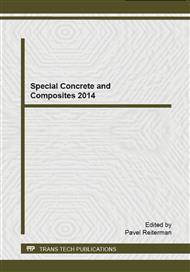[1]
Komonen, J., Penttala, V., Effects of high temperature on the pore structure and strength of plain and polypropylene fiber reinforced cement pastes, Fire Technology. 39 (2003) 23-34.
Google Scholar
[2]
Černý, R., Podebradska, J., Totova, M., Toman, J., Drchalova, J., Rovnanikova, P., Bayer, P., Hygrothermal Properties of Glass Fiber Reinforced Cements Subjected to Elevated Temperature, Materials and Structures, 37 (2004) 597-607.
DOI: 10.1007/bf02483289
Google Scholar
[3]
Li, Z.J., Zhou, X.M., Shen, B., Fiber-cement extrudates with perlite subjected to high temperatures, Journal of Materials in Civil Engineering. 16 (2004) 221-229.
DOI: 10.1061/(asce)0899-1561(2004)16:3(221)
Google Scholar
[4]
L. Zuda, J. Drchalová, P. Rovnaník, P. Bayer, Z. Keršner, R. Černý, Alkali-activated aluminosilicate composite with heat-resistant lightweight aggregates exposed to high temperatures: mechanical and water transport properties. Cement and Concrete Composites 32(2010).
DOI: 10.1016/j.cemconcomp.2009.11.009
Google Scholar
[5]
Ingrao, C., Lo Giudice, A., Tricase, C., Mbohwa, C., Rana, R, The use of basalt aggregates in the production of concrete for the prefabrication industry: Environmental impact assessment, interpretation and improvement, Journal of Cleaner Production. 75 (2014).
DOI: 10.1016/j.jclepro.2014.04.002
Google Scholar
[6]
Jiang, CH., Fan, K., Wu, F., Chen, D., Experimental study on the mechanical properties and microstructure of chopped basalt fibre reinforced concrete, Materials & Design. 58 (2014) 187-193.
DOI: 10.1016/j.matdes.2014.01.056
Google Scholar
[7]
Kabay, N., Abrasion resistance and fracture energy of concretes with basalt fiber, Construction and Building Materials. 501 (2014) 95-101.
DOI: 10.1016/j.conbuildmat.2013.09.040
Google Scholar
[8]
Holčapek, O., Reiterman, P., Jogl, M., Konvalinka, P., 2014, Destructive and non-destructive testing of high temperature influence on refractory fiber composite, Advanced Materials Research, Vol. 982, pp.145-148.
DOI: 10.4028/www.scientific.net/amr.982.145
Google Scholar
[9]
Koňáková, D., Vejmelková, E., Špedlová, V., Polozhiy, K., Černý, R., 2014, Cement composites for high temperature applications, Advanced Materials Research, Vol. 982, pp.154-158.
DOI: 10.4028/www.scientific.net/amr.982.154
Google Scholar
[10]
Holčapek, O., Reiterman, P., Konvalinka, P., 2014, Mechanical and rheological properties of aluminous cement under high temperatures, Advaced Materials Research, Vol. 982, pp.141-144.
DOI: 10.4028/www.scientific.net/amr.982.141
Google Scholar
[11]
Štubna, A., Trník A., Vozár L., Thermomechanical analysis of quartz porcelain in temperature cycles, Ceramics International. 33 (2007) 1287-1291.
DOI: 10.1016/j.ceramint.2006.04.024
Google Scholar
[12]
Roels, S., Carmeliet. J., Hens. H., Adan. O., Brocken, H., Černý, R., Pavlík, Z., Hall, C., Kumaran, K., Pel, L., Plagge, R., Interlaboratory Comparison of Hygric Properties of Porous Building Materials, Journal of Thermal Envelope and Building Science. 27 (2004).
DOI: 10.1177/1097196304042119
Google Scholar


